Apple said on Monday that it had sold more than 300,000 iPads on the device’s first day on the market, a figure that included preorders. That met the expectations of financial analysts who were keeping tabs on the release of the company’s highly anticipated tablet computer. … [RBC Capital] had been expecting Apple to sell 300,000 to 400,000 iPads over the whole weekend.
—NYT
Apple Inc. said it sold more than 300,000 iPads in the U.S. on the first day the device went on sale Saturday, tempering Wall Street’s highflying expectations for the much-hyped multimedia tablet computer. … Analysts on average had expected first-day iPad sales of 400,000 to 500,000 units. Some analysts, such as Piper Jaffray analyst Gene Munster, had even higher sales projections of 600,000 to 700,000 units.
— WSJ
Posted Under:
The Trend Industry by Rob Walker on April 6, 2010
Comments Off on iPad expectations
This Smithsonian.com writeup on Penguin paperbacks makes some interesting observations about how their success was tied to their object-ness — both in terms of design and branding:
Penguin’s graphic design played a large part in the company’s success. Unlike other publishers, whose covers emphasized the title and author of the book, Penguin emphasized the brand. The covers contained simple, clean fonts, color-coding (orange for fiction, dark blue for biography) and that cute, recognizable bird. The look helped gain headlines. The Sunday Referee declared “the production is magnificent” and novelist J. B. Priestley raved about the “perfect marvels of beauty and cheapness.”
Posted Under:
The Designed Life by Rob Walker on April 6, 2010
Comments Off on Books, the idea: “Beauty and cheapness”
- 200 Examples of anti-Obama merchandise: During health care debate, 2008-2010. Via Coudal.
- The joy (and pain) of abundance: “The overstuffed houses of hoarders and the ultra-minimal, bare bones interiors featured in design magazines are two ends of a spectrum of beliefs about homes and happiness. I could just as easily take on the hoarders as the zen-modernists, except for one thing — no one is advocating the hoarder lifestyle. Even the hoarders view their condition with shame. Minimalism, on the other hand, is often preached as a lifestyle nirvana — a blissful, transcendent state achieved by letting go of material things.” From a very enjoyable essay on aesthetics and abundance (including some thoughts about evolutionary factors that I’ve tried to articulate in the past, with little success, but that I agree with completely).
- Digital decay and the archival cloud: Interesting Nicholas Carr rumination on potential threats to digital archives kept in “the cloud.” My impression is that a lot of people are thinking about these problems, and that we’re still likely to end up with a massive glut of digital “information.” The quality of what gets kept may vary widely, of course.
- The nonexistent purpose of people: “When it comes to religion, most believers reason that we’re here ‘for’ some divine purpose. Even if they’re not particularly religious, people often reference some vague purpose to human existence, such as ‘to love one another’. As Albert Camus wrote, ‘revolt against man is also directed against God’. But many of us go one step further than this, saying that individual members of our species exist ‘for’ a special reason.” Via Mindhacks.
- The ROFLCon II Schedule @ ROFLCon.
- Can you judge an album by its cover?: Somebody is doing a study to find out. You can participate via this link if you like.
These links compiled via delicious, and repurposed here with plug-in Postalicious. Not enough stuff? Not the stuff you wanted? Try visiting unconsumption.tumblr.com, murketing.tumblr.com, and/or the Consumed Facebook page.
For obvious reasons the discussion of the idea of books has focused quite heavily on the e-variety these last few days, as speculation abounds over The Meaning of the iPad For The Printed Word.
The Telegraph reports on a book that will have a sort of instant sequel “assembled from the best comments by readers of” the author’s Website. A publishing type who is involved comments:
With devices like the iPad nearly at our shores and more routes for communication than ever before, I believe that especially in non-fiction, the distance between the author and reader should start to disappear. Authors will become more like curators and take influence from their readers’ suggestions during and after they have written their work.
Meanwhile, Nicholas Carr suggests that what we’re headed for is books becoming multimedia apps, in a sort of post-reader world. He quotes some other publishing-world guy:
“The definition of the book itself seems up for grabs,” he said at a recent media industry powwow. Unlike traditional e-book readers, which had a rather old-fashioned attachment to linear text, the iPad opens the doors to incorporating all sorts of “cool stuff,” Makinson continued. “We will be embedding audio, video and streaming into everything we do.” He foresees sprinkling movie clips among Jane Austen’s paragraphs in future editions of “Pride and Prejudice.”
Hm. What do you think?
Perhaps I’ll “curate” the best of your responses into a follow-up post!
With video?
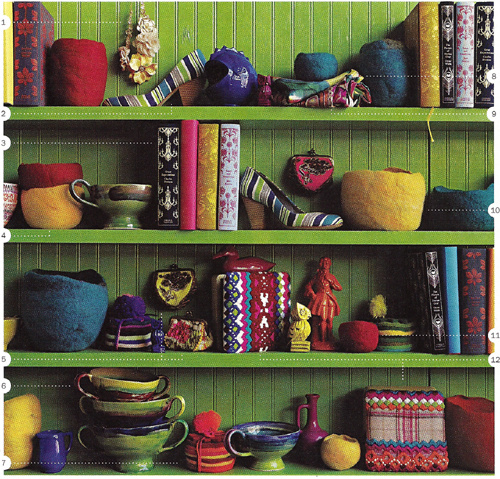
Via Jezebel, click for more.
In a thoughtful comment to a December 2009 post on Significant Objects (in which I noted examples of art made from books, and ruminated on the possibilities of “upcycling with words”), Jim Rosenau mentioned a Nicholson Baker New Yorker essay called “Books As Furniture.” I finally got around to tracking that down and reading it this weekend, and I must thank Mr. Rosenau. The piece, from 1995, is amazing.
It’s in the New Yorker archive, here, but I guess you have to be a subscriber to access it. It’s going to take me more than one post to deal with all the great observations in this essay (are you out there RAOJ?) but by chance there’s opening to get started today.
In a nutshell, Baker starts noticing the books used as props in home decor catalogs, and looks into it. And, you know, he does that Nicholson Baker thing, of learning a shocking amount, conveying it to us with one insight after another, and basically just making the whole experience a reading pleasure. More specifics in the days ahead, but in the short term I happened to become aware by coincidence just today that Jezebel (a site I visit rarely, not that there’s anything wrong with it) has a kind of recurring feature that involves … scrutinizing catalogs. The image at the top of this post, for instance, is from an Anthropologie catalog.
You’ll notice, of course, the books, looking quite pleasing there with all the other stuff on that just-so shelf. But those aren’t props (or at least not just props) like the books that Baker noticed in various catalogs: Anthropologie evidently actually sells ’em:
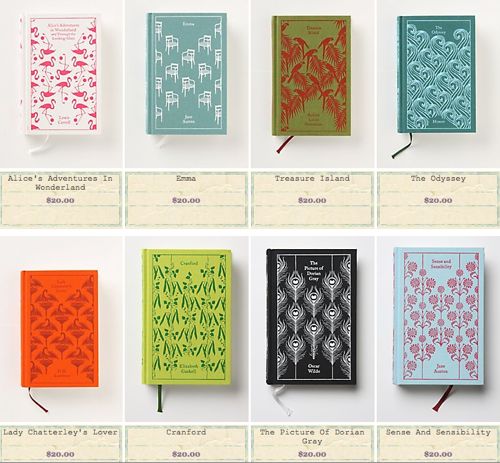
Anthropologie book selection. Click for more.
And let’s face it: They look great.
More on Baker’s 1995 piece as this series continues.
This Retro Thing post caught my eye:
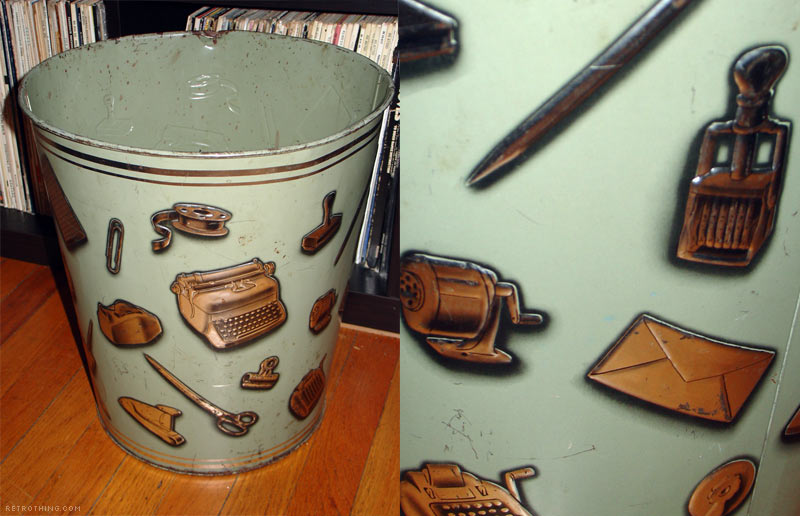
Via Retro Thing. Click to read Retrothing post.
It’s not just a thing decorated with images of other things, it’s a thing for discarding things, decorated with images of things.
This post is part of an occasional series.
Posted Under:
Things/Thinking by Rob Walker on April 5, 2010
Comments Off on Pictures of Stuff: Stuff on an object
 Okay I so I dialed back the constant mentions of Significant Objects on this site, but this might be of interest to some of you: We have a special week-long event underway, a set of objects “curated” for us by an actual curator — Paola Antonelli, of MoMA — with the stories co-published on one of my very favorite sites, Core77. A story a day, all week.
Okay I so I dialed back the constant mentions of Significant Objects on this site, but this might be of interest to some of you: We have a special week-long event underway, a set of objects “curated” for us by an actual curator — Paola Antonelli, of MoMA — with the stories co-published on one of my very favorite sites, Core77. A story a day, all week.
Pretty cool. Proceeds for our current batch of object auctions are all going to Girls Write Now. Your help in spreading the word about this is always appreciated.
One or two more pieces of news about S.O. in the next week or so, but I promise not to get carried away.
Posted Under:
Things/Thinking by Rob Walker on April 5, 2010
Comments Off on Significant Objects X Paola Antonelli X Core77
 SLIGHTLY USED
SLIGHTLY USED
What can we learn from our (seemingly) pointless tools?
A predictable thought crossed my mind: how funny, how absurd, that the cutting tool, the ur-thing of functionality, has evolved into a premium-priced stylish object that seems more suitable for display than for use. But after listening to the first 30 episodes of the radio series (it starts up again in May), which bring the story up to about 300 B.C., I’ve had second thoughts about that glib analysis.
Read the column in the April 4, 2010, New York Times Magazine, or here.
Discuss, make fun of, or praise this column to the skies at the Consumed Facebook page.
Posted Under:
Consumed,
Things/Thinking by Rob Walker on April 4, 2010
Comments Off on In The New York Times Magazine: Slightly Used
Via Book of Joe:

Workaholic Pillow. Click for more.

Workaholic Pillow. Click for more.
Part of an occasional series.
Also added, of course, to Things That Look Like Other Things.
Posted Under:
Things/Thinking by Rob Walker on April 3, 2010
Comments Off on The idea of the book, cont’d: As pillow
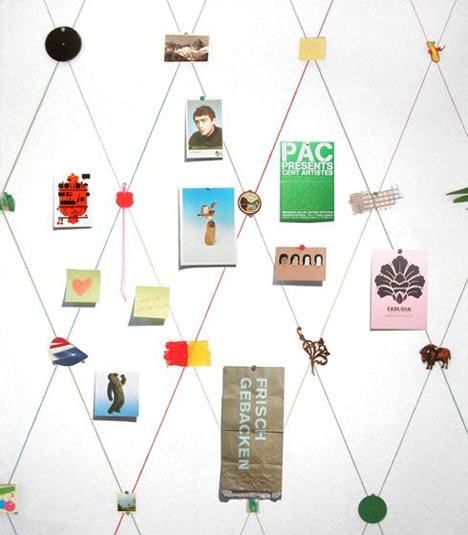
By Sarah Kueng. Click for more info.
Creator Sarah Kueng writes: “I composed the wallpaper from everyday objects and found objects. The objects are arranged in a grid designed to generate calm. The wallpaper inspires the viewer to add personal objects. The result is an interesting mixture of new and old, and two and three dimensions.”
Via Core77’s Lisa Smith, who has more to say, here.
Pictures of Stuff is an occasional series.
Core77 points to Music Machinery’s suggestion that Amazon could do a lot more with the data it is collecting (or could be collecting) via Kindle software: “It keeps track of where you are in a book so that if you switch devices (from an iPhone to a Kindle or an iPad or desktop), you can pick up exactly where you left off.” This leads Music Machinery to suggest the generation of LastFM-style charts and so on, identifying various trends about how we read and so on. The suggestion that jumped out at me:
Trophy Books – books that are most frequently purchased, but never actually read.
I’m not personally excited about user-data-harvesting, but that is, in fact, pretty interesting. And funny.
Surely if such information does end up being collected, it could be cross-worked with book-imagery that we may one day display on our devices and virtual shelves?
See the Music Machinery post for more of Paul Lemere’s ideas. Earlier posts in this occasional Murketing series are here.
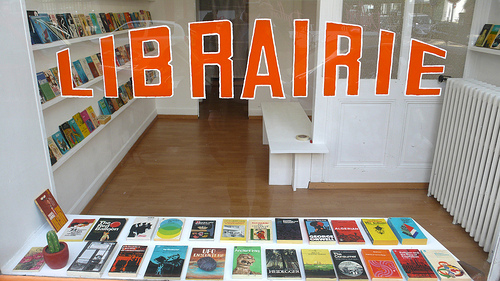
LIBRARIE. Click for more info
“CONRAD BAKKER: Untitled Project: LIBRAIRIE [Geneva] is a simulated bookshop made of hundreds of hand carved and painted copies of used paperback books from the 1960’s and 1970’s whose subjects range from social issues and existential philosophies to DIY crafts and self improvement. These representations of vintage paperbacks reveal their status as public things in the gathering of persons/things around a specific issue or matter of concern. The very space of the constructed bookshop/librairie reiterates the objective of public things as it becomes a literal platform for considering the relationships between persons, things and ideas.”
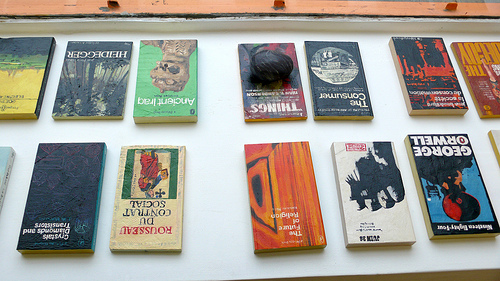
LIBRARIE. Click for more images.
Posted Under:
Artists by Rob Walker on March 31, 2010
Comments Off on The idea of the book, cont’d: Book-like sculptures
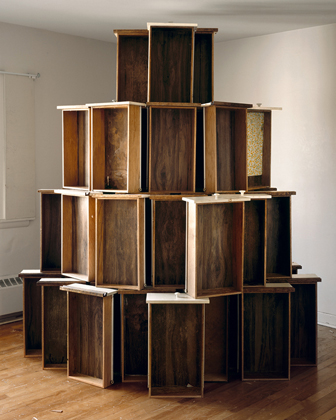
Tower of Drawers, by James Nizam. Click for details.
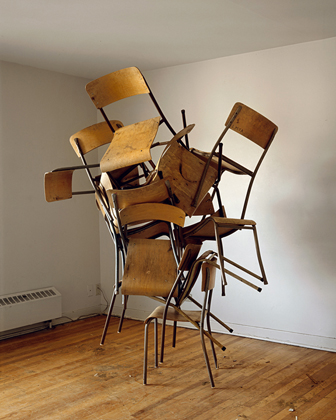
Entanglement of Chairs, by James Nizam. Click for details.
Like many other entries in this occasional series: via Junk Culture.
Posted Under:
Artists,
Things/Thinking by Rob Walker on March 31, 2010
Comments Off on Pictures of Stuff, cont’d: Object-clumping
NYT:
Among other changes heralded by the e-book era, digital editions are bumping book covers off the subway, the coffee table and the beach. That is a loss for publishers and authors, who enjoy some free advertising for their books in printed form: if you notice the jackets on the books people are reading on a plane or in the park, you might decide to check out “The Girl With the Dragon Tattoo” or “The Help,” too.
And:
Some readers expect makers of electronic devices to add functions that allow users to broadcast what they’re reading. “People like to show off what they’re doing and what they like,” said Maud Newton, a popular book blogger. “So eventually there will be a way for people to do that with e-readers.”
Perhaps what will happen with e-readers will be an option for displaying the cover of the book you want people to think you’re reading — a mobile version of the digital “bookshelf” I proposed here.
See also: “Destroyed Copy of ‘Buying In’ as Kindle Holder.”
This post is part of an occasional series.




 "
"




 SLIGHTLY USED
SLIGHTLY USED

















 Kim Fellner's book
Kim Fellner's book  A
A